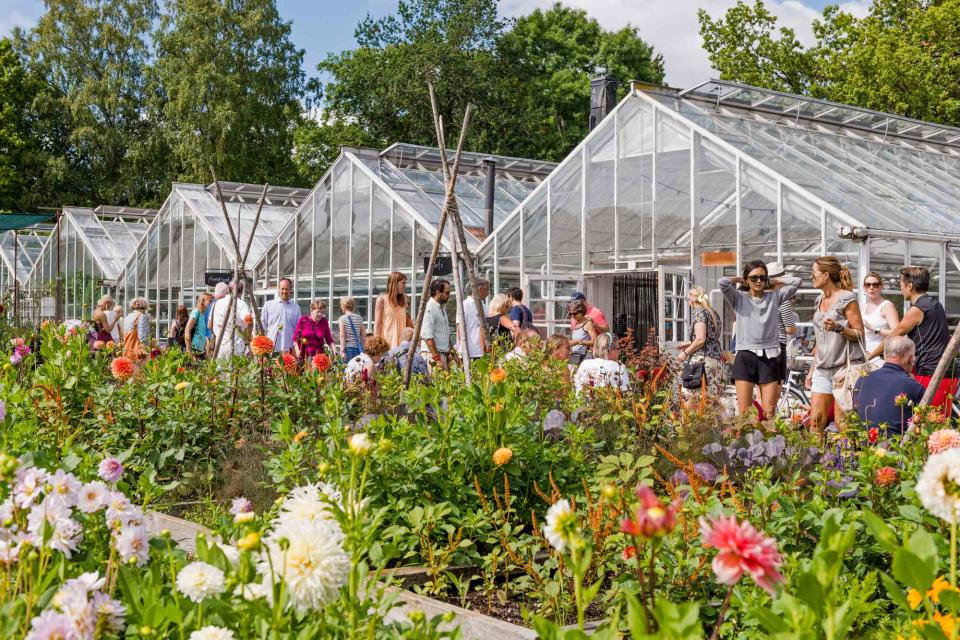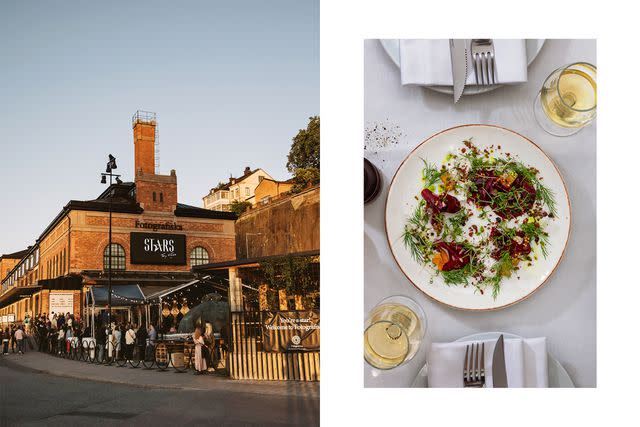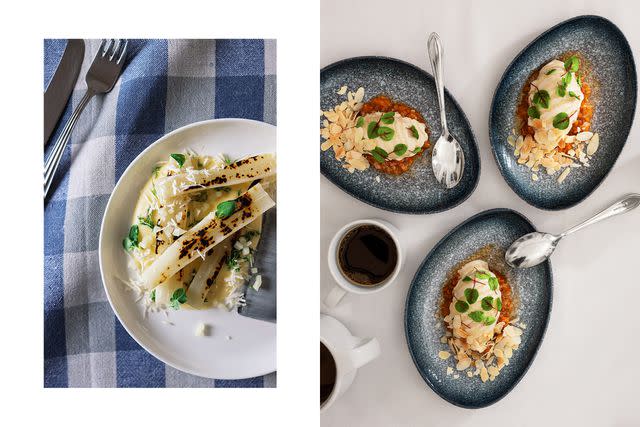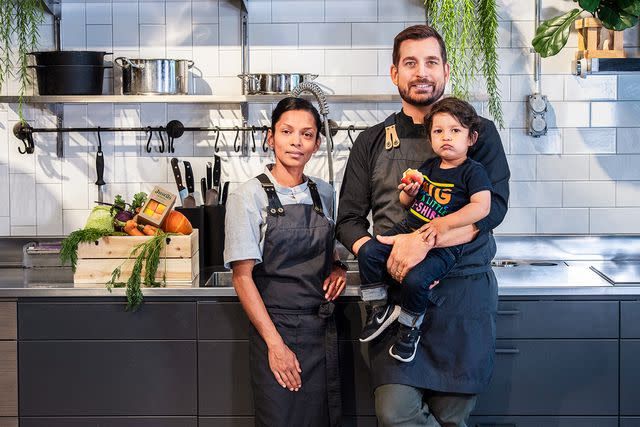These Chefs in Stockholm Are Leading a Delicious, Zero-waste Food Movement
Here are eight places to eat in Sweden's capital, from cozy bistros to an urban farm.

Gregor Lengler/laif/Redux
Rosendals Trädgård, an urban farm that grows produce and composts waste for several Stockholm restaurants.Inside a haute vegan restaurant connected to a nightclub beneath a bridge in wintry Stockholm, I was having one heck of a meal. Using such kitchen wizardry as dehydrating, smoking, fermenting, and jam-making, the chefs behind the Hamnvakten neighborhood restaurant Växthuset had preserved every bit of fresh produce they could from Sweden’s growing season — roughly May through October — to brighten the December gloom. Bracing horseradish powder and pickled mustard seeds balanced earthy beet carpaccio dappled with sweet pear jam. Confit of grilled mushrooms got a sly pop of baby shiso. Jerusalem-artichoke chips and sauerkraut mayo amped up the umami of smoked tempeh. It could’ve been a meal served at any fine-dining restaurant — except it made liberal use of kitchen scraps, with every vegetable peel or herb stem utilized in some form.
I found a similar sense of vivaciousness everywhere I ate in the Swedish capital. Outside, the clouds hung low in the frigid air and the sky was dark by 3 p.m. But inside, the restaurants felt positive and vibrant. This city on the Baltic Sea is in the throes of a no-waste dining revolution that combines age-old Swedish ingenuity with 21st-century concern about our impact on the planet, and it’s pushing chefs to get creative.
Some credit goes to the Swedish government, which has committed to meeting the United Nations’ Sustainable Development Goal of halving food waste by 2030, and some to the world’s most famous climate activist. “Greta Thunberg has made us more aware,” said Filip Lundin, the founder of Sopköket, a catering service and café whose name translates to “waste kitchen.” A third of Swedish food is thrown away, Lundin told me, adding that it constitutes 10 percent of the country’s emissions. “It’s more than air travel.”
He’s right: generally speaking, food waste is responsible for higher emissions than the airline industry. So despite the fact that I’d flown to Stockholm from my home in New York City, I felt I was offsetting some of my carbon footprint by patronizing restaurants that are minimizing food waste. Since 2015, Lundin has rescued more than 35 tons of imperfect, surplus, or mispackaged food from markets and restaurants.

From left: KASJA GÖRANSSON/COURTESY OF FOTOGRAFISKA; COURTESY OF VAXTHUSET
From left: The dining venues at the photography museum Fotografiska minimize food waste through partnerships with other local businesses; the beet carpaccio on Växthuset’s menu is accented with dill, rye crisp, and pickled mustard seed.When we met at his café in the Söderhallarna food hall, it was fika time. We took our Swedish coffee break over cups brewed from beans salvaged in January. “The market was throwing them away because they were labeled ‘Christmas coffee,’ but it’s nice arabica,” Lundin said. At his café, you might get an organic broccoli soup made entirely with ingredients diverted from the scrap heap. Your portion might be smaller than an American expects, but that’s another strategy for decreasing waste. “If you want more, extra is free,” Lundin said, “but people often want less than they think.”
Sopköket is casual, but fine dining represents Stockholm’s no-waste vanguard. On the top-floor restaurant of the chic photography museum Fotografiska, the maître d’ showed off jars of kombucha brewed from kitchen leftovers. “All the staff have them at home, and relatives of the staff have the relatives of the kombucha, and their relatives have them,” he boasted of the team’s propagation efforts. “We upcycle as much as possible.”
Uneaten bread goes to a nearby brewery, which uses it as an ingredient in a beer named Echo; spent grain and sediment are dried and milled into a flour that goes back to Fotografiska to make more bread. A local ceramics company grinds down shells from servings of oysters and mussels to incorporate into tableware. “It’s a circle that never ends,” chef Gustaf Sandfridsson said. The kitchen embodies the idea that sustainability can still be pleasurable in plant-forward dishes such as baked cabbage with pickled cabbage trimmings in sorrel beurre blanc dusted with dried, smoked lamb’s heart. “We use animals more like a taste, and we take the whole animal, not just the nice parts,” said Sandfridsson, who led the kitchen at the time of my visit. “It’s a new world if you’re an old-school chef.”
Yet these methods hark back to preindustrial times. “People didn’t have refrigeration,” Sandfridsson explained. “We’d pickle in season to save produce for winter when it’s nice to have something that tastes like summer.” My dirty martini, made with pickled plum juice and gin steeped with foraged lingonberries, warmed me right up. I was dining in Fotografiska’s casual Bistro Bread & Wine, where the savory jam in the cheese course was made from the trimmings of red onions used in preparations in the prix fixe restaurant.
The next morning, I walked to Rosendals Trädgård, Stockholm’s most famous urban farm, located inside Kungliga Djurgården, the Royal National City Park. The biodynamic education center and café was started in 1983 “by two gardeners who wanted to save the world with carrots,” Victoria Lagne, its head of communications, told me. We walked through plant-filled greenhouses, then out to the garden where, in a fenced-off area, research was under way.

From left: COURTESY OF RESTAURANG OXENSTIERNAN; COURTESY OF VAXTHUSET
From left: Salsify, a root vegetable that can be harvested in winter, at the restaurant Oxenstiernan; at Växthuset, ice cream is topped with a fruit compote and toasted almonds.“If we divide all arable land available to the projected world population of 2050, that’s just under half an acre per human on Earth,” she explained. Rosendals was experimenting with crops and animals to measure the amount of food that could be produced in that space. Their findings showed a need to curb our reliance on animal proteins. “We need fat in our diets, so you’d eat dairy. But in such a small space, what people consume would have to be what a tenth of a cow can give,” she said. “We are developing a curriculum for teaching the public an understanding of proportions.”
I was still hungry even after eating a massive hunk of Rosendals’ heritage-grain sourdough, so I made my way to the quiet neighborhood of Östermalm. There, former Fotografiska chef Elvira Lindqvist has launched Oxenstiernan in an 18th-century farmhouse. After creamy Jerusalem-artichoke soup garnished with herbs and a swirl of fermented celeriac juice, I had the only protein on the menu: a smoky fish cake made with pike perch raised sustainably in a closed-system aquafarm. My “intermezzo” — a croquette filled with leek fondue — had been made with the allium’s underused dark-green tops.
“Most farmers are used to selling a little piece of a crop. But on most vegetables, everything is edible,” Lindqvist said. “I tell farmers, ‘Send me the whole plant.’ If I can lift different parts of a vegetable to a level that makes people understand something they never had before, it’s a way to change mindsets.”
It’s a mission she shares with another of Stockholm’s prominent female chefs, Jessie Sommarström, the creative director of Urban Deli, a chain of four groceries that house buzzy restaurants and even, at the Sveavägen location, a hotel. To reach the dining room there, I walked through the grocery section, past pots of living herbs raised sustainably year-round at Grönska, Stockholm’s massive vertical farm. The delicate fish fritters I ordered were the result of a collaboration with the nonprofit Axfoundation, which has developed a way to process brax, an indigenous lake fish that has been underutilized in part because its boniness makes it tedious to prepare.

ANNA HÅLLAMS/COURTESY OF URBAN DELI
Urban Deli’s creative director Jessie Sommarström with her partner, Gordon Grimlund, and their son Justus.Next came the carapace of an enormous crab, a creature whose claws are often the only part consumed. I did my best to leave no waste, devouring its meat, roe, and unctuous fat, which some chefs might have removed. Throughout the meal, I sipped from a cocktail menu listing ingredients such as “rescue cucumber,” “rescue orange Falernum,” and “rescue raspberry shrub.” It might seem like little more than a cute description, but on Sommarström’s menu, “rescue” has a serious purpose. “We inform guests because we want to make it easy for them to make sustainable choices without telling them what’s right or wrong,” she said.
An even more diplomatic approach was in evidence at Bonnie’s. The restaurant serves as the main dining room of the Bank Hotel, which has received the independent Green Key certification for sustainability. “We talk a lot about how to have a five-star standard and still minimize food waste,” chef Fanny Rönnblom told me over a lunch of broccoli soup and beef carpaccio. The kitchen composts and uses leftovers — the morning’s saffron buns become the afternoon’s biscotti and also go into the evening’s ice cream, for instance.
Rönnblom admitted it can be difficult to balance those conscientious measures with the level of luxury guests expect. “We have to have strawberries on the breakfast buffet 365 days a year,” she said. After talking to her, I understood that we, as travelers, need to help chefs in their efforts to treat food more sustainably by shifting our thinking. And as the restaurants I visited proved, there’s no reason not to.
A version of this story first appeared in the April 2023 issue of Travel + Leisure under the headline "From the Ground Up."
For more Travel & Leisure news, make sure to sign up for our newsletter!
Read the original article on Travel & Leisure.

